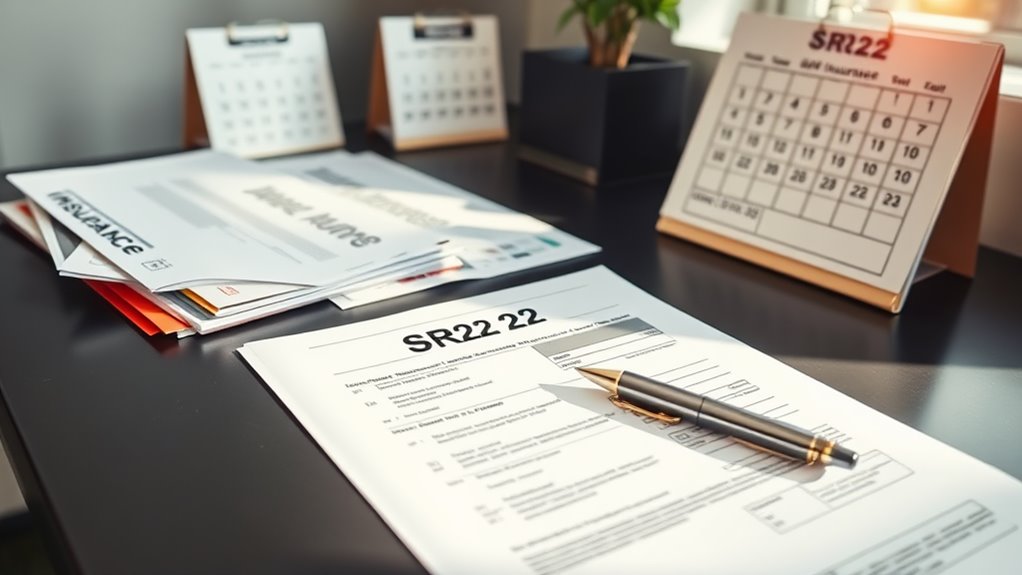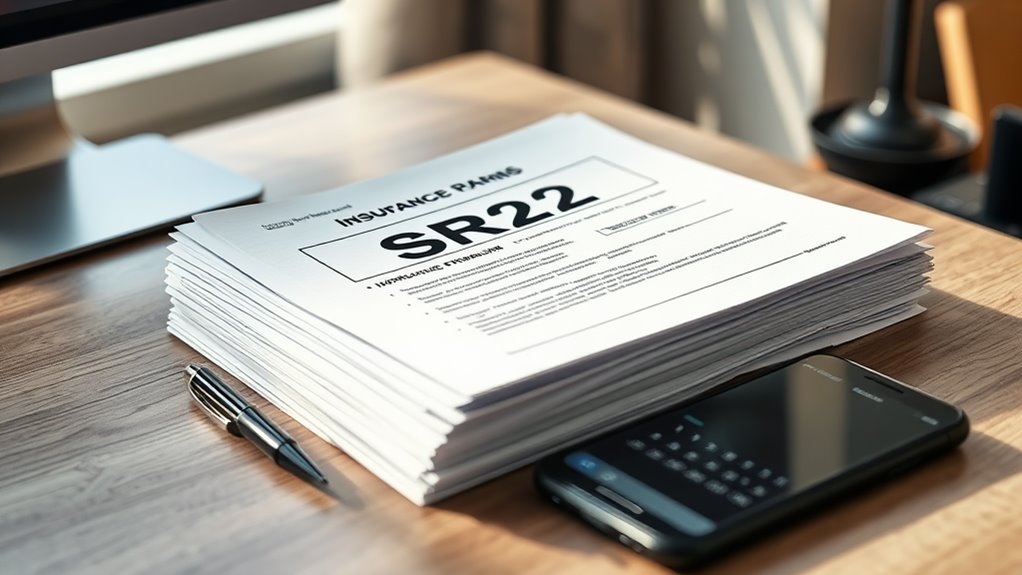
Steering through the world of insurance documentation can feel like walking a tightrope, where balance is key to avoiding costly missteps. Timely and organized documentation is vital for smooth processes, especially when it comes to significant filings like the SR22. You'll want to establish a solid foundation to guarantee you're prepared for any deadlines. Discovering effective strategies can make all the difference in maintaining your coverage and peace of mind.
Key Takeaways
- Organize all necessary documentation, including identity, address, and financial proofs, to streamline the filing process.
- Complete the SR22 form accurately, ensuring all personal and policy details are correct to avoid delays.
- Submit the SR22 filing promptly to meet legal obligations and prevent penalties or license suspension.
- Monitor the status of your SR22 with the DMV and maintain communication with your insurance provider for updates.
- Keep a systematic record of all correspondence and documents related to your insurance for easy access and reference.
Understand the SR22 Filing Requirements

Maneuvering SR-22 filing requirements can feel overwhelming, but understanding the essentials simplifies the process.
An SR-22 is a Certificate of Financial Responsibility that proves you have the minimum auto insurance coverage required. This filing is necessary if you've faced DUIs, multiple traffic violations, uninsured driving, or a license suspension. It's important to remember that your insurance company is responsible for filing the SR-22 with your state's DMV, usually for a fee around $25. Most states require this documentation, though Florida and Virginia use the FR-44 instead. Additionally, SR-22 insurance can remain in effect for up to three years, depending on the severity of your violations.
Gather Necessary Documentation
When it comes to securing insurance, gathering the necessary documentation is crucial for a smooth application process.
Start by collecting proof of identity, like your passport, government-issued ID, and Social Security card. If you're a non-citizen, include your resident permit.
Next, gather proof of address through recent utility bills, bank statements, or a rental agreement.
Accumulate financial documents, such as salary slips, income tax returns, and bank account statements, to demonstrate your income stability.
Organize insurance-related documents, including policy agreements, beneficiary forms, and claims history.
Finally, maintain up-to-date medical information, which includes medical history forms and prescriptions.
Having these documents ready will expedite your insurance application and guarantee you meet all requirements efficiently.
Complete the SR22 Form Accurately
Accurate completion of the SR22 form is crucial for ensuring compliance with state regulations and facilitating a smooth filing process. You should verify that all personal and policy details are correct and up-to-date to prevent delays.
Familiarize yourself with your state's specific SR22 requirements, as they vary considerably. Choose an insurance provider experienced in handling SR22 filings, as they'll prepare and submit the form on your behalf.
Expect to pay a small filing fee, usually between $15 and $25. After submission, confirm that the insurer or state has processed the SR22 accurately.
Maintaining continuous coverage is essential, as lapses can lead to penalties or license suspension, affecting your driving status.
Submit the SR22 Filing Promptly

Submitting your SR22 filing promptly is vital to confirm you meet legal obligations and avoid potential penalties. If you've been notified that you need an SR22 due to a DUI, DWI, or other traffic offenses, act quickly.
Typically, your insurance provider files this form with the state DMV, but it's your responsibility to verify it's done on time. SR22s are usually required for three years, depending on your state, so staying compliant is important.
Remember, any lapse in coverage can lead to license suspension and additional fines. Compare quotes from different providers, as costs can vary.
Keeping your insurance active throughout this period will help you maintain compliance and prevent complications down the line.
Monitor the Status of Your SR22
Monitoring the status of your SR22 is vital to guarantee you remain compliant with state requirements. To check your SR22 status, contact your state's Department of Motor Vehicles (DMV), as procedures may vary.
Stay compliant by regularly checking your SR22 status with your state's DMV, as processes differ across states.
Some states offer online portals for quick verification, while others may charge a fee. Keeping a record of all communications with the DMV guarantees you have proof of your inquiries.
It's critical to avoid lapses in coverage, as they can extend your SR22 filing period and lead to potential license suspension. Make timely premium payments, set up automated payments, and track your policy renewal dates to maintain continuous coverage.
Stay proactive in reviewing notifications from your insurer to prevent any surprises.
Maintain Communication With Your Insurance Provider
Maintaining open lines of communication with your insurance provider is essential for guaranteeing a smooth experience throughout your policy's lifecycle. Responding quickly to queries not only reduces anxiety but also builds trust.
Use clear and concise messaging to guarantee your communications are straightforward. Regular updates on your claim status keep you informed and engaged. Don't hesitate to utilize various communication channels that suit your preferences, whether it's email, phone, or online portals.
Be transparent about processes and actions taken, and recognize common concerns you may have. Offering personalized support and showing empathy can go a long way in easing your worries.
Proactive guidance helps you navigate complex processes, making your relationship with your provider more effective and reassuring.
Keep Records of All Correspondence and Documents

Effective record-keeping is essential for managing your insurance documentation efficiently. Start by creating a centralized system where you store all your correspondence and documents, whether in a filing cabinet or a digital folder.
Categorize these documents by policy type for easier access and organization. Utilize digital tools, like cloud storage and AI-driven platforms, to securely store and automate your document management.
Organizing documents by policy type and leveraging digital tools enhances accessibility and streamlines your document management process.
Consistently label files to enhance searchability and guarantee you regularly update your organization system to reflect any changes. Perform routine backups to prevent data loss, and implement version control to keep track of document updates.
This systematic approach will help you maintain compliance and reduce errors, making future claims and audits much smoother.
Conclusion
Staying on top of your insurance documentation is like tending a garden; regular care and attention yield a healthy, flourishing outcome. By understanding SR22 requirements, gathering necessary documents, and maintaining open communication with your provider, you can guarantee a smooth process. Remember to submit your filings promptly and keep track of everything. With these tips, you'll cultivate a hassle-free experience and avoid any last-minute surprises, letting your insurance needs grow without a hitch.